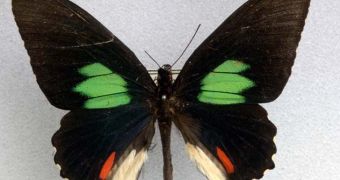For many years, biologists have been puzzled by the amazing colors that butterflies' wings have. They change depending on how light hits them, and a while ago it was discovered that the hues are not produced by pigments, like in any other living species. It was found that specialized formations of cells, arranged in neatly-defined geometrical patterns, were responsible for this ability. The discovery was made using X-ray scattering techniques on two types of butterflies, LiveScience reports.
The lycaenid and papilionid families were therefore imaged in 3D, so that researchers could look closely at their wing structure. It was found that gyroids – tiny formations on the wings – were directly responsible for scattering light, producing about the same effect as a crystal does when illuminated. “There's been a lot of interest in how these butterfly colors work, but until now all the work was done using two-dimensional electron microscope images, and these are complex three-dimensional structures. We were able to show conclusively that these were indeed gyroids,” says the lead researcher on the work, graduate student Vinodkumar Saranathan.
He conducted the investigation in the lab of Yale University biologist Richard Prum. Details of the methods used, as well as the full results, are presented in the June 15 issue of the esteemed journal Proceedings of the National Academy of Sciences (PNAS). Saranathan explains that gyroids can best be described as stacks of three-bladed boomerangs. Each of the formations making them up is oriented in a different direction, and several boomerangs are placed on top of each other. From above, the gyroid resembles a fan. Special types of these formations, called double gyroids, have also been identified.
“The double gyroid is found in a lot of synthetic and biological systems. It is found within specialized compartments of both plant and animal cells that have evolved over millions of years of selection for optimal function. The size of the gyroid structure is what determines the color. If you were to shrink the structure it would become bluer, if you were to expand it, it would turn red. You can finely tune the color you want,” the lead researcher adds.
But the finding has applications extending beyond the field of biology. “In polymer-based photonic crystal engineering the Holy Grail is to produce a material that has a single gyroid structure. Butterflies have been doing it for millions of years. We can use this material in the butterflies as a template to manufacture these single gyroids,” Saranathan concludes.

 14 DAY TRIAL //
14 DAY TRIAL //